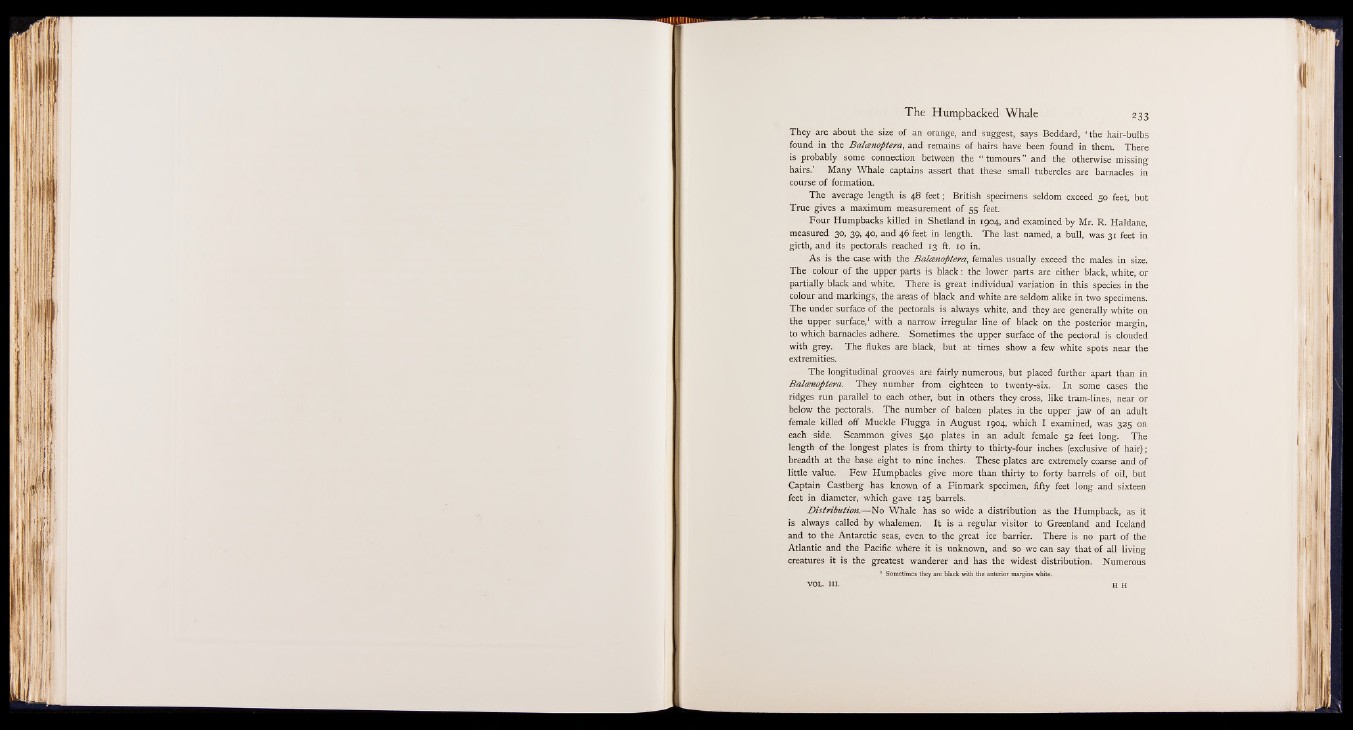
They are about the size of an orange, and suggest, says Beddard, ‘ the hair-bulbs
found in the Balcenoptera, and remains of hairs have been found in them. There
is probably some connection between the “ tumours ” and the otherwise missing
hairs.’ Many Whale captains assert that these small tubercles are barnacles in
course of formation.
The average length is 48 feet; British specimens seldom exceed 50 feet, but
True gives a maximum measurement of 55 feet.
Four Humpbacks killed in Shetland in 1904, and examined by Mr. R. Haldane,
measured 30, 39, 40, and 46 feet in length. The last named, a bull, was 31 feet in
girth, and its pectorals reached 13 ft. 10 in.
As is the case with the Balcenoptera, females usually exceed the males in size.
The colour of the upper parts is black: the lower parts are either black, white, or
partially black and white. There is great individual variation in this species in the
colour and markings, the areas of black and white are seldom alike in two specimens;
The under surface of the pectorals is always white, and they are generally white on
the upper surface,1 with a narrow irregular line of black on the posterior margin,
to which barnacles adhere. Sometimes the upper surface of the pectoral is clouded
with grey. The flukes are black, but at times show a few white spots near the
extremities.
The longitudinal grooves are fairly numerous, but placed further apart than in
Balcenoptera. They number from eighteen to twenty-six. In some cases the
ridges run parallel to each other, but in others they cross, like tram-lines, near or
below the pectorals. The number of baleen plates in the upper jaw of an adult
female killed off Muckle Flugga in August 1904, which I examined, was 325 on
each side. Scammon gives 540 plates in an adult female 52 feet long. The
length of the longest plates is from thirty to thirty-four inches (exclusive of hair);
breadth at the base eight to nine inches. These plates are extremely coarse and of
little value. Few Humpbacks give more than thirty to forty barrels of oil, but
Captain Castberg has known of a Finmark specimen, fifty feet long and sixteen
feet in diameter, which gave 125 barrels.
Distribution.— No Whale has so wide a distribution as the Humpback, as it
is always called by whalemen. It is a regular visitor to Greenland and Iceland
and to the Antarctic seas, even to the great ice barrier. There is no part of the
Atlantic and the Pacific where it is unknown, and so we can say that of all living
creatures it is the greatest wanderer and has the widest distribution. Numerous
1 Sometimes they are black with the anterior margins white.
VOL. III. H H